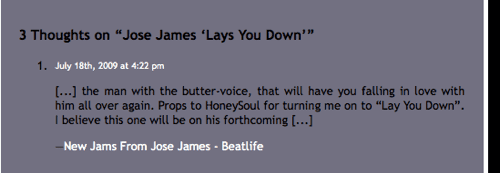The terms pingbacks and trackbacks are used almost interchangeably, and are pretty much the same thing on the surface. They actually utilize different technologies and originated for different purposes, but these days they are becoming more intertwined. I’m just going to call them trackbacks for the purpose of this post.
What are they?
Essentially both are forms of notifications or communications between blogs.
For example, if I write a blog post and in it I link to a blog post on another site, an excerpt of my post containing the link will show up on that blogger’s site in their Comments section, along with a link back to my post. Since trackbacks are handled through comments, the blogger gets to moderate it like any other comment. So he/she will be able to see that I referenced their blog and if they approve the comment I now have a link from their site to mine. This is a trackback.
Here’s an example from my music blog, beatlife.net. In this case I used the trackback simply to give credit to the other blog as the source of my post. I wrote a post (excerpt below) and I linked to a post on another blog – HoneySoul.

The author of HoneySoul approved my trackback so below you see an excerpt from my post listed in her comments. The white text at the bottom is a link back to my post.

I have to say that WordPress’ documentation is a little confusing on the difference between pingbacks and trackbacks and leads me to believe they are consolidating the 2 under the name pingback. In your dashboard they will show up as “pingbacks” but they are displayed as per WP’s description of trackbacks, with an editable excerpt in your comments.
Anyway, what’s important is how you can use them.
Trackbacks can be used strategically to:
1) drive more traffic to your site
2) gain attention from a blogger
3) join in the community conversation
It’s very simple, all you have to do is write a blog post that includes a link to a post by another blogger. Now that blogger has to have trackbacks enabled, otherwise your link won’t be published in their comments. Most bloggers do, but you can check by just looking at the comments of their posts and see if there are any. Assuming that blogger considers your trackback to be valuable, and not spammy, a link to your post shows up in their comments, as illustrated in the screenshots above. Voila, your blog is now exposed to a whole new audience, and there’s a level of validation since the blogger has to approve your trackback.
Even if a blogger doesn’t have trackbacks enabled on their site, linking to another blog can still get you noticed by that blogger since he will probably see your incoming link in his WordPress dashboard.
I want to emphasize that this has to be done in an authentic and natural way. If you try and game this method it will be obvious – your trackback comment will not be accepted and you will damage your reputation. So use this method only when you actually have something to say. Perhaps you read an opinion piece from a blogger and you want to present your own opinion, or develop the idea and conversation further.

